A Business Research Dissertation: Emotional Intelligence at Tesco
VerifiedAdded on 2023/01/09
|7
|1769
|69
Report
AI Summary
This business research dissertation examines the adverse impact of emotional intelligence within Tesco. The introduction highlights the significance of emotional intelligence in organizations, while also addressing its potential downsides, such as manipulation and selfishness. The research aims to identify the negative impacts of emotional intelligence in Tesco's workplace, focusing on its effects on organizational culture. The objectives include understanding emotional intelligence, identifying its adverse impacts on employee behavior and culture, and analyzing strategies for Tesco to manage these influences. The literature review explores the concept of emotional intelligence, its positive and negative effects, and strategies for fostering emotionally intelligent teams. The methodology section discusses the use of quantitative research methods, including questionnaires and surveys, along with primary and secondary data sources. The report concludes with an overview of Tesco, emphasizing the need to address the dark side of emotional intelligence to maintain a positive organizational culture. The research utilizes both primary and secondary data collection methods, including questionnaires, surveys and literature review. The references include books, journals, and online resources that support the research findings.
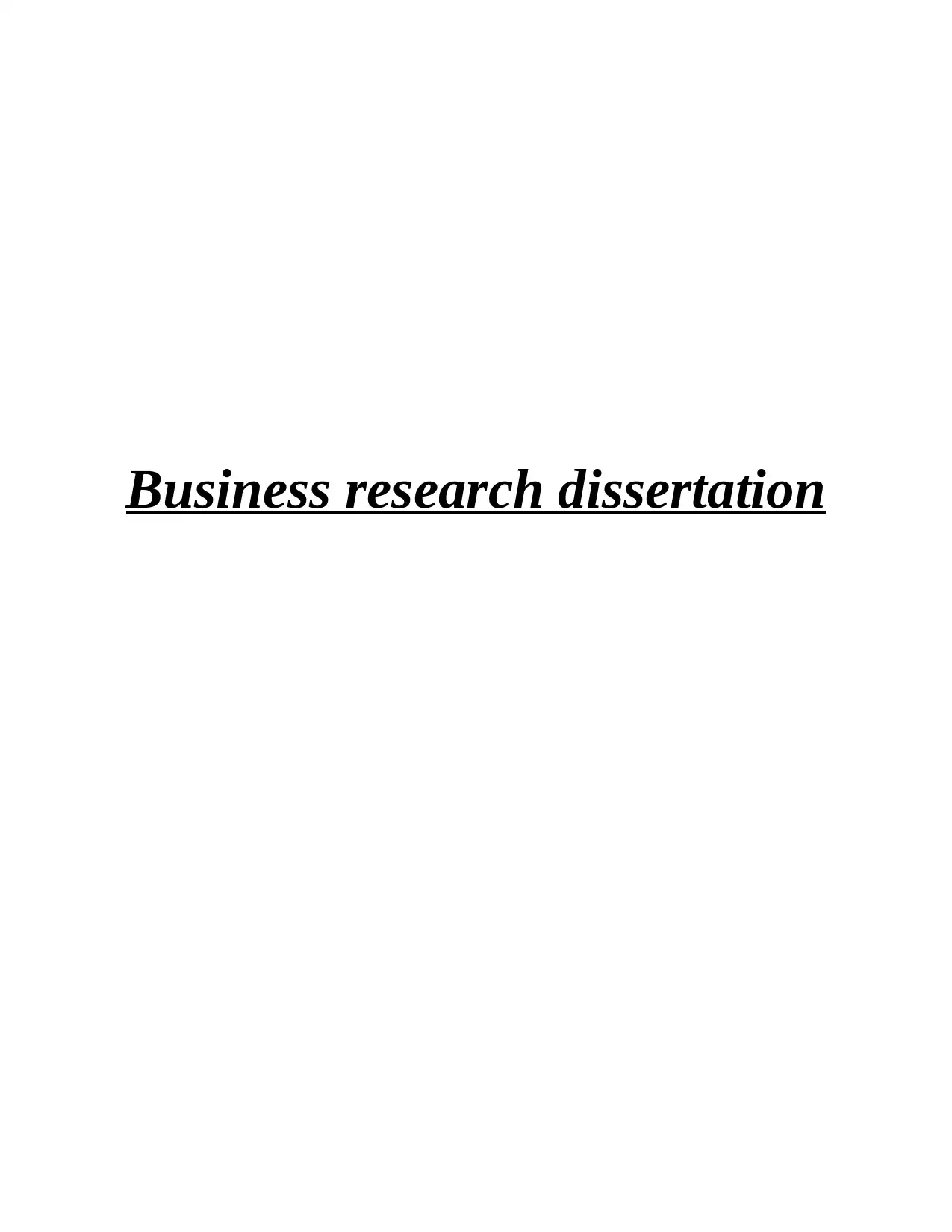
Business research dissertation
Paraphrase This Document
Need a fresh take? Get an instant paraphrase of this document with our AI Paraphraser
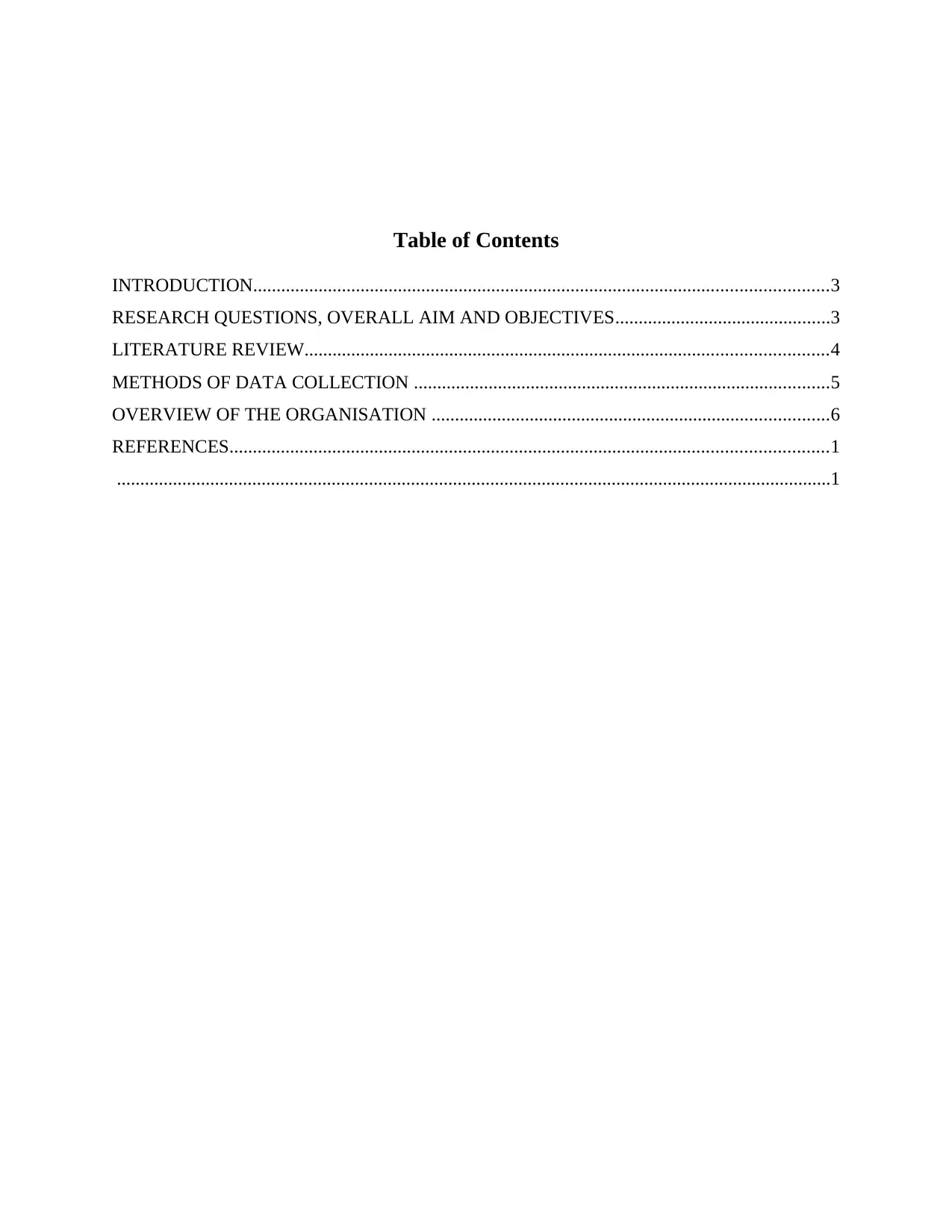
Table of Contents
INTRODUCTION...........................................................................................................................3
RESEARCH QUESTIONS, OVERALL AIM AND OBJECTIVES..............................................3
LITERATURE REVIEW................................................................................................................4
METHODS OF DATA COLLECTION .........................................................................................5
OVERVIEW OF THE ORGANISATION .....................................................................................6
REFERENCES................................................................................................................................1
.........................................................................................................................................................1
INTRODUCTION...........................................................................................................................3
RESEARCH QUESTIONS, OVERALL AIM AND OBJECTIVES..............................................3
LITERATURE REVIEW................................................................................................................4
METHODS OF DATA COLLECTION .........................................................................................5
OVERVIEW OF THE ORGANISATION .....................................................................................6
REFERENCES................................................................................................................................1
.........................................................................................................................................................1
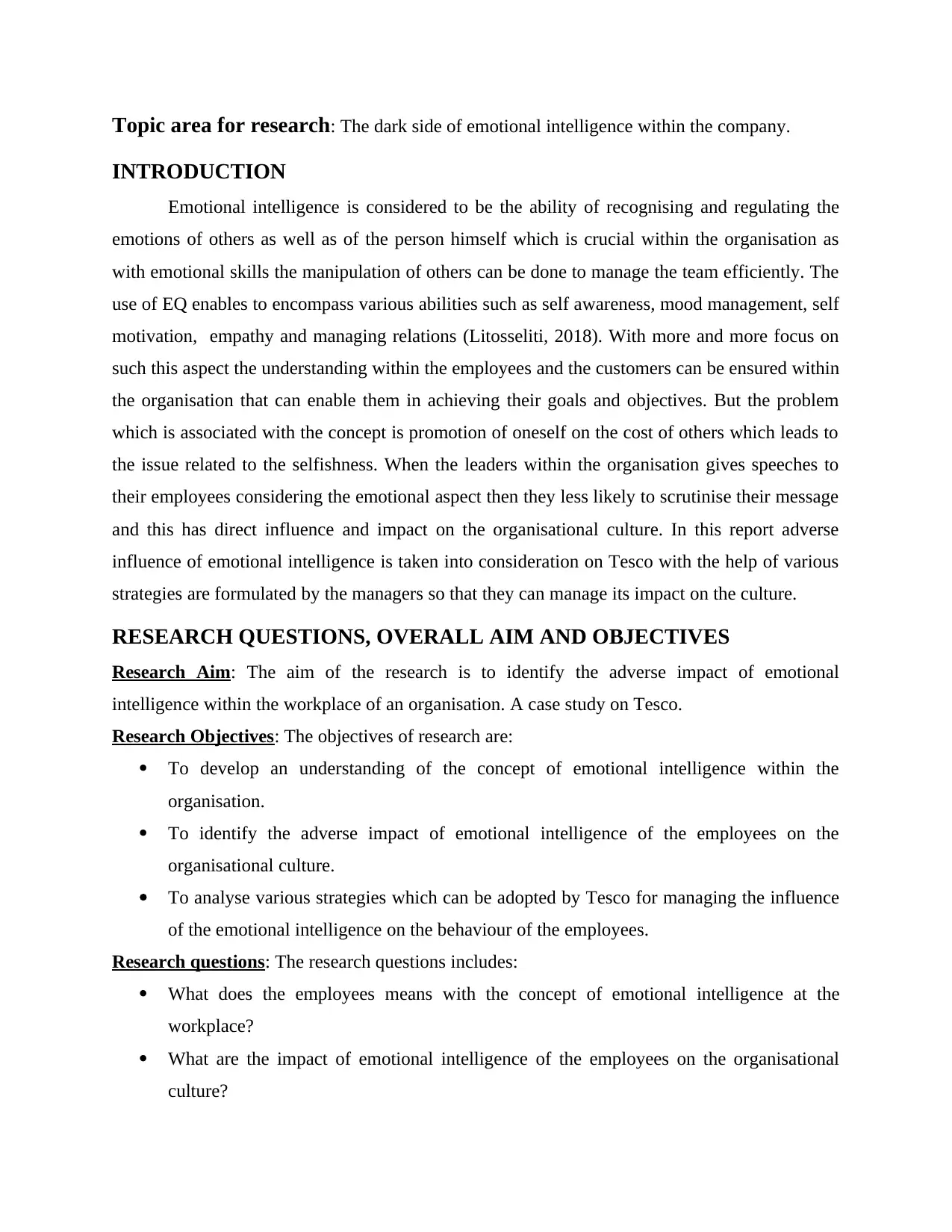
Topic area for research: The dark side of emotional intelligence within the company.
INTRODUCTION
Emotional intelligence is considered to be the ability of recognising and regulating the
emotions of others as well as of the person himself which is crucial within the organisation as
with emotional skills the manipulation of others can be done to manage the team efficiently. The
use of EQ enables to encompass various abilities such as self awareness, mood management, self
motivation, empathy and managing relations (Litosseliti, 2018). With more and more focus on
such this aspect the understanding within the employees and the customers can be ensured within
the organisation that can enable them in achieving their goals and objectives. But the problem
which is associated with the concept is promotion of oneself on the cost of others which leads to
the issue related to the selfishness. When the leaders within the organisation gives speeches to
their employees considering the emotional aspect then they less likely to scrutinise their message
and this has direct influence and impact on the organisational culture. In this report adverse
influence of emotional intelligence is taken into consideration on Tesco with the help of various
strategies are formulated by the managers so that they can manage its impact on the culture.
RESEARCH QUESTIONS, OVERALL AIM AND OBJECTIVES
Research Aim: The aim of the research is to identify the adverse impact of emotional
intelligence within the workplace of an organisation. A case study on Tesco.
Research Objectives: The objectives of research are:
To develop an understanding of the concept of emotional intelligence within the
organisation.
To identify the adverse impact of emotional intelligence of the employees on the
organisational culture.
To analyse various strategies which can be adopted by Tesco for managing the influence
of the emotional intelligence on the behaviour of the employees.
Research questions: The research questions includes:
What does the employees means with the concept of emotional intelligence at the
workplace?
What are the impact of emotional intelligence of the employees on the organisational
culture?
INTRODUCTION
Emotional intelligence is considered to be the ability of recognising and regulating the
emotions of others as well as of the person himself which is crucial within the organisation as
with emotional skills the manipulation of others can be done to manage the team efficiently. The
use of EQ enables to encompass various abilities such as self awareness, mood management, self
motivation, empathy and managing relations (Litosseliti, 2018). With more and more focus on
such this aspect the understanding within the employees and the customers can be ensured within
the organisation that can enable them in achieving their goals and objectives. But the problem
which is associated with the concept is promotion of oneself on the cost of others which leads to
the issue related to the selfishness. When the leaders within the organisation gives speeches to
their employees considering the emotional aspect then they less likely to scrutinise their message
and this has direct influence and impact on the organisational culture. In this report adverse
influence of emotional intelligence is taken into consideration on Tesco with the help of various
strategies are formulated by the managers so that they can manage its impact on the culture.
RESEARCH QUESTIONS, OVERALL AIM AND OBJECTIVES
Research Aim: The aim of the research is to identify the adverse impact of emotional
intelligence within the workplace of an organisation. A case study on Tesco.
Research Objectives: The objectives of research are:
To develop an understanding of the concept of emotional intelligence within the
organisation.
To identify the adverse impact of emotional intelligence of the employees on the
organisational culture.
To analyse various strategies which can be adopted by Tesco for managing the influence
of the emotional intelligence on the behaviour of the employees.
Research questions: The research questions includes:
What does the employees means with the concept of emotional intelligence at the
workplace?
What are the impact of emotional intelligence of the employees on the organisational
culture?
⊘ This is a preview!⊘
Do you want full access?
Subscribe today to unlock all pages.

Trusted by 1+ million students worldwide
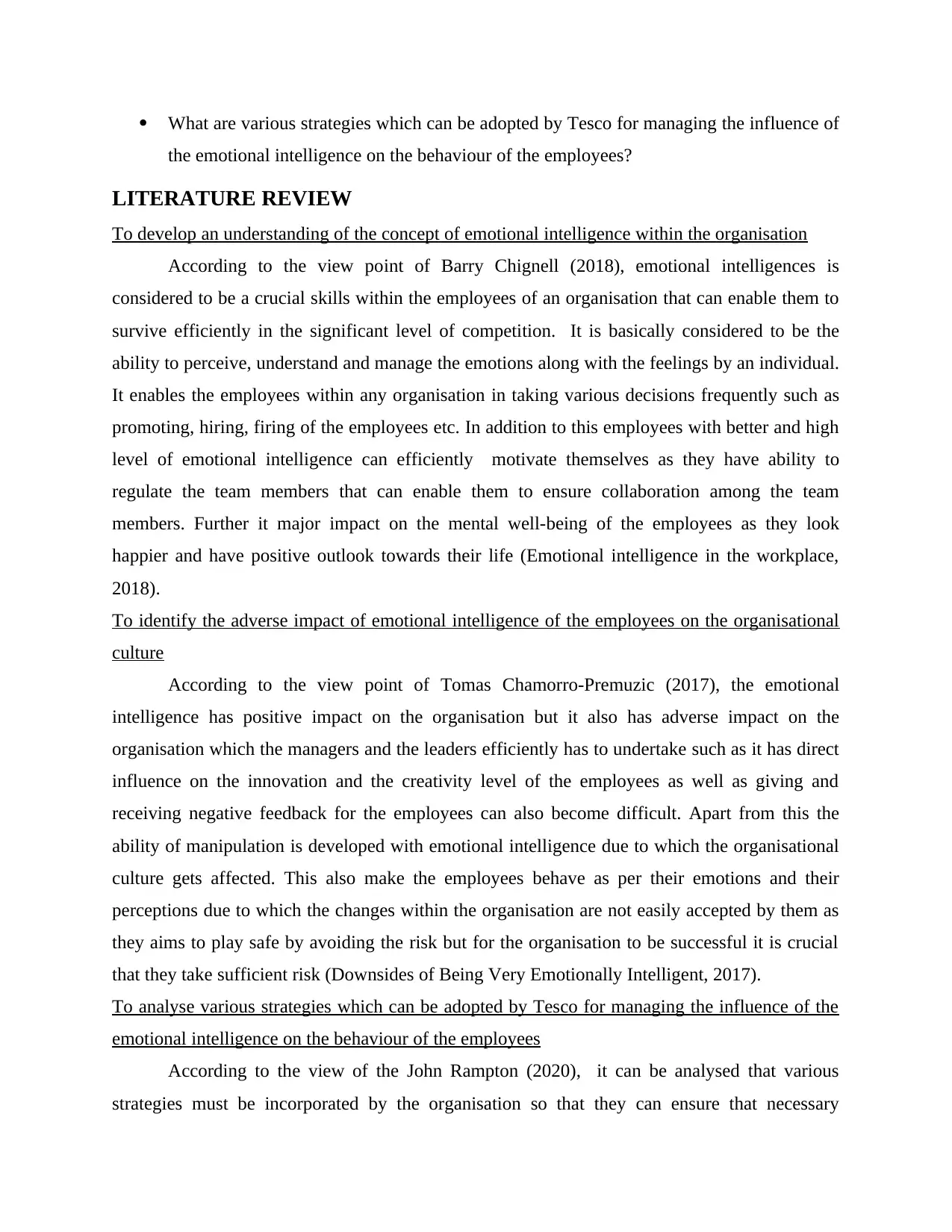
What are various strategies which can be adopted by Tesco for managing the influence of
the emotional intelligence on the behaviour of the employees?
LITERATURE REVIEW
To develop an understanding of the concept of emotional intelligence within the organisation
According to the view point of Barry Chignell (2018), emotional intelligences is
considered to be a crucial skills within the employees of an organisation that can enable them to
survive efficiently in the significant level of competition. It is basically considered to be the
ability to perceive, understand and manage the emotions along with the feelings by an individual.
It enables the employees within any organisation in taking various decisions frequently such as
promoting, hiring, firing of the employees etc. In addition to this employees with better and high
level of emotional intelligence can efficiently motivate themselves as they have ability to
regulate the team members that can enable them to ensure collaboration among the team
members. Further it major impact on the mental well-being of the employees as they look
happier and have positive outlook towards their life (Emotional intelligence in the workplace,
2018).
To identify the adverse impact of emotional intelligence of the employees on the organisational
culture
According to the view point of Tomas Chamorro-Premuzic (2017), the emotional
intelligence has positive impact on the organisation but it also has adverse impact on the
organisation which the managers and the leaders efficiently has to undertake such as it has direct
influence on the innovation and the creativity level of the employees as well as giving and
receiving negative feedback for the employees can also become difficult. Apart from this the
ability of manipulation is developed with emotional intelligence due to which the organisational
culture gets affected. This also make the employees behave as per their emotions and their
perceptions due to which the changes within the organisation are not easily accepted by them as
they aims to play safe by avoiding the risk but for the organisation to be successful it is crucial
that they take sufficient risk (Downsides of Being Very Emotionally Intelligent, 2017).
To analyse various strategies which can be adopted by Tesco for managing the influence of the
emotional intelligence on the behaviour of the employees
According to the view of the John Rampton (2020), it can be analysed that various
strategies must be incorporated by the organisation so that they can ensure that necessary
the emotional intelligence on the behaviour of the employees?
LITERATURE REVIEW
To develop an understanding of the concept of emotional intelligence within the organisation
According to the view point of Barry Chignell (2018), emotional intelligences is
considered to be a crucial skills within the employees of an organisation that can enable them to
survive efficiently in the significant level of competition. It is basically considered to be the
ability to perceive, understand and manage the emotions along with the feelings by an individual.
It enables the employees within any organisation in taking various decisions frequently such as
promoting, hiring, firing of the employees etc. In addition to this employees with better and high
level of emotional intelligence can efficiently motivate themselves as they have ability to
regulate the team members that can enable them to ensure collaboration among the team
members. Further it major impact on the mental well-being of the employees as they look
happier and have positive outlook towards their life (Emotional intelligence in the workplace,
2018).
To identify the adverse impact of emotional intelligence of the employees on the organisational
culture
According to the view point of Tomas Chamorro-Premuzic (2017), the emotional
intelligence has positive impact on the organisation but it also has adverse impact on the
organisation which the managers and the leaders efficiently has to undertake such as it has direct
influence on the innovation and the creativity level of the employees as well as giving and
receiving negative feedback for the employees can also become difficult. Apart from this the
ability of manipulation is developed with emotional intelligence due to which the organisational
culture gets affected. This also make the employees behave as per their emotions and their
perceptions due to which the changes within the organisation are not easily accepted by them as
they aims to play safe by avoiding the risk but for the organisation to be successful it is crucial
that they take sufficient risk (Downsides of Being Very Emotionally Intelligent, 2017).
To analyse various strategies which can be adopted by Tesco for managing the influence of the
emotional intelligence on the behaviour of the employees
According to the view of the John Rampton (2020), it can be analysed that various
strategies must be incorporated by the organisation so that they can ensure that necessary
Paraphrase This Document
Need a fresh take? Get an instant paraphrase of this document with our AI Paraphraser
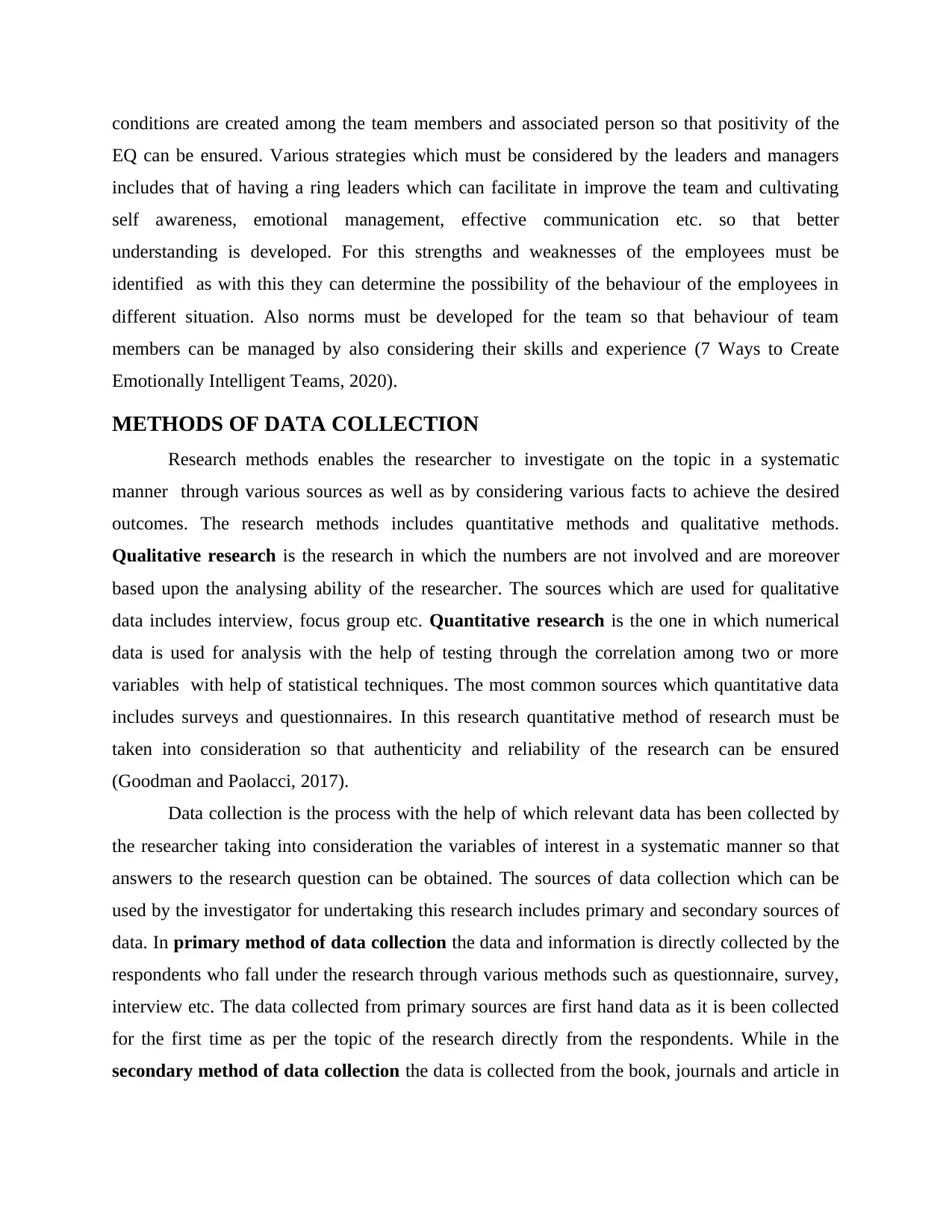
conditions are created among the team members and associated person so that positivity of the
EQ can be ensured. Various strategies which must be considered by the leaders and managers
includes that of having a ring leaders which can facilitate in improve the team and cultivating
self awareness, emotional management, effective communication etc. so that better
understanding is developed. For this strengths and weaknesses of the employees must be
identified as with this they can determine the possibility of the behaviour of the employees in
different situation. Also norms must be developed for the team so that behaviour of team
members can be managed by also considering their skills and experience (7 Ways to Create
Emotionally Intelligent Teams, 2020).
METHODS OF DATA COLLECTION
Research methods enables the researcher to investigate on the topic in a systematic
manner through various sources as well as by considering various facts to achieve the desired
outcomes. The research methods includes quantitative methods and qualitative methods.
Qualitative research is the research in which the numbers are not involved and are moreover
based upon the analysing ability of the researcher. The sources which are used for qualitative
data includes interview, focus group etc. Quantitative research is the one in which numerical
data is used for analysis with the help of testing through the correlation among two or more
variables with help of statistical techniques. The most common sources which quantitative data
includes surveys and questionnaires. In this research quantitative method of research must be
taken into consideration so that authenticity and reliability of the research can be ensured
(Goodman and Paolacci, 2017).
Data collection is the process with the help of which relevant data has been collected by
the researcher taking into consideration the variables of interest in a systematic manner so that
answers to the research question can be obtained. The sources of data collection which can be
used by the investigator for undertaking this research includes primary and secondary sources of
data. In primary method of data collection the data and information is directly collected by the
respondents who fall under the research through various methods such as questionnaire, survey,
interview etc. The data collected from primary sources are first hand data as it is been collected
for the first time as per the topic of the research directly from the respondents. While in the
secondary method of data collection the data is collected from the book, journals and article in
EQ can be ensured. Various strategies which must be considered by the leaders and managers
includes that of having a ring leaders which can facilitate in improve the team and cultivating
self awareness, emotional management, effective communication etc. so that better
understanding is developed. For this strengths and weaknesses of the employees must be
identified as with this they can determine the possibility of the behaviour of the employees in
different situation. Also norms must be developed for the team so that behaviour of team
members can be managed by also considering their skills and experience (7 Ways to Create
Emotionally Intelligent Teams, 2020).
METHODS OF DATA COLLECTION
Research methods enables the researcher to investigate on the topic in a systematic
manner through various sources as well as by considering various facts to achieve the desired
outcomes. The research methods includes quantitative methods and qualitative methods.
Qualitative research is the research in which the numbers are not involved and are moreover
based upon the analysing ability of the researcher. The sources which are used for qualitative
data includes interview, focus group etc. Quantitative research is the one in which numerical
data is used for analysis with the help of testing through the correlation among two or more
variables with help of statistical techniques. The most common sources which quantitative data
includes surveys and questionnaires. In this research quantitative method of research must be
taken into consideration so that authenticity and reliability of the research can be ensured
(Goodman and Paolacci, 2017).
Data collection is the process with the help of which relevant data has been collected by
the researcher taking into consideration the variables of interest in a systematic manner so that
answers to the research question can be obtained. The sources of data collection which can be
used by the investigator for undertaking this research includes primary and secondary sources of
data. In primary method of data collection the data and information is directly collected by the
respondents who fall under the research through various methods such as questionnaire, survey,
interview etc. The data collected from primary sources are first hand data as it is been collected
for the first time as per the topic of the research directly from the respondents. While in the
secondary method of data collection the data is collected from the book, journals and article in
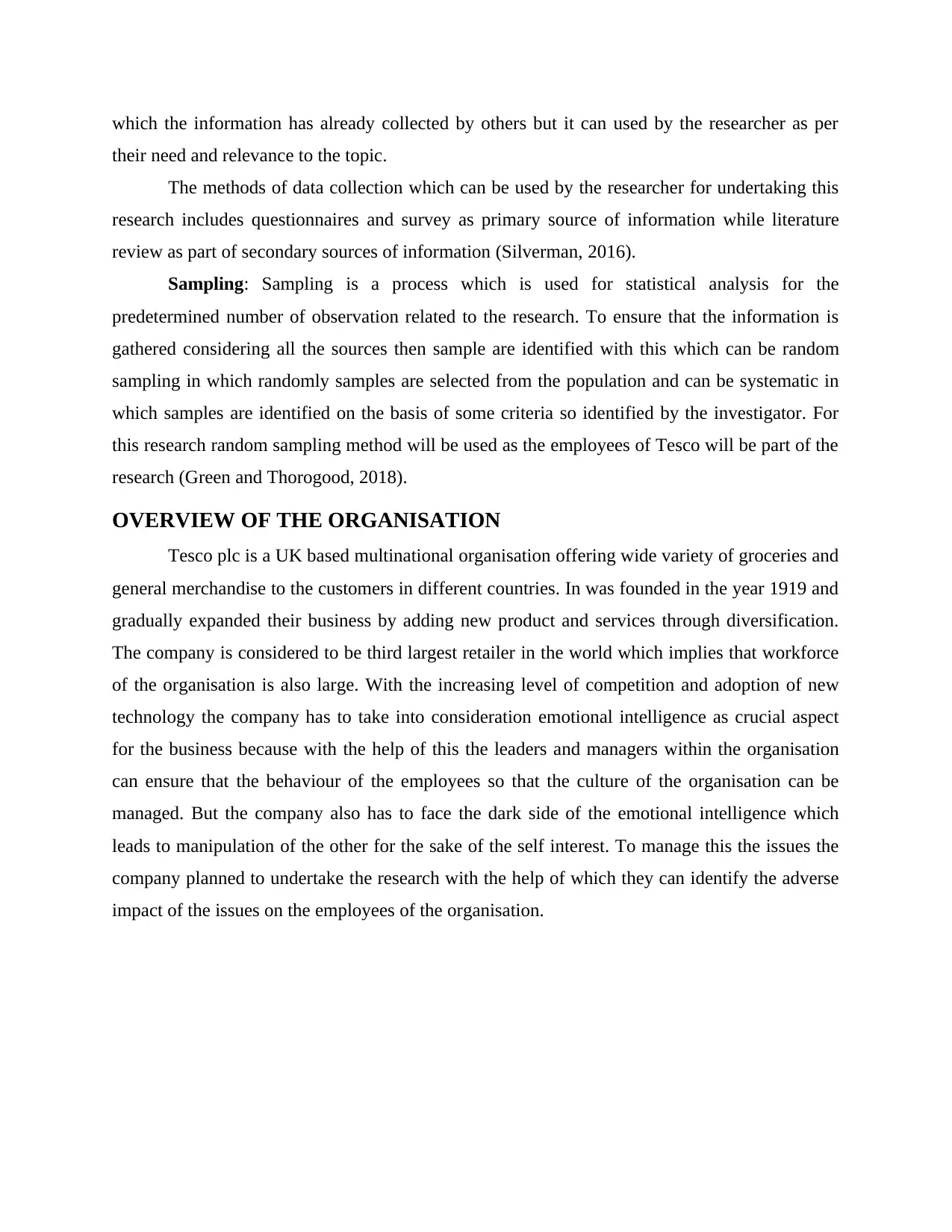
which the information has already collected by others but it can used by the researcher as per
their need and relevance to the topic.
The methods of data collection which can be used by the researcher for undertaking this
research includes questionnaires and survey as primary source of information while literature
review as part of secondary sources of information (Silverman, 2016).
Sampling: Sampling is a process which is used for statistical analysis for the
predetermined number of observation related to the research. To ensure that the information is
gathered considering all the sources then sample are identified with this which can be random
sampling in which randomly samples are selected from the population and can be systematic in
which samples are identified on the basis of some criteria so identified by the investigator. For
this research random sampling method will be used as the employees of Tesco will be part of the
research (Green and Thorogood, 2018).
OVERVIEW OF THE ORGANISATION
Tesco plc is a UK based multinational organisation offering wide variety of groceries and
general merchandise to the customers in different countries. In was founded in the year 1919 and
gradually expanded their business by adding new product and services through diversification.
The company is considered to be third largest retailer in the world which implies that workforce
of the organisation is also large. With the increasing level of competition and adoption of new
technology the company has to take into consideration emotional intelligence as crucial aspect
for the business because with the help of this the leaders and managers within the organisation
can ensure that the behaviour of the employees so that the culture of the organisation can be
managed. But the company also has to face the dark side of the emotional intelligence which
leads to manipulation of the other for the sake of the self interest. To manage this the issues the
company planned to undertake the research with the help of which they can identify the adverse
impact of the issues on the employees of the organisation.
their need and relevance to the topic.
The methods of data collection which can be used by the researcher for undertaking this
research includes questionnaires and survey as primary source of information while literature
review as part of secondary sources of information (Silverman, 2016).
Sampling: Sampling is a process which is used for statistical analysis for the
predetermined number of observation related to the research. To ensure that the information is
gathered considering all the sources then sample are identified with this which can be random
sampling in which randomly samples are selected from the population and can be systematic in
which samples are identified on the basis of some criteria so identified by the investigator. For
this research random sampling method will be used as the employees of Tesco will be part of the
research (Green and Thorogood, 2018).
OVERVIEW OF THE ORGANISATION
Tesco plc is a UK based multinational organisation offering wide variety of groceries and
general merchandise to the customers in different countries. In was founded in the year 1919 and
gradually expanded their business by adding new product and services through diversification.
The company is considered to be third largest retailer in the world which implies that workforce
of the organisation is also large. With the increasing level of competition and adoption of new
technology the company has to take into consideration emotional intelligence as crucial aspect
for the business because with the help of this the leaders and managers within the organisation
can ensure that the behaviour of the employees so that the culture of the organisation can be
managed. But the company also has to face the dark side of the emotional intelligence which
leads to manipulation of the other for the sake of the self interest. To manage this the issues the
company planned to undertake the research with the help of which they can identify the adverse
impact of the issues on the employees of the organisation.
⊘ This is a preview!⊘
Do you want full access?
Subscribe today to unlock all pages.

Trusted by 1+ million students worldwide
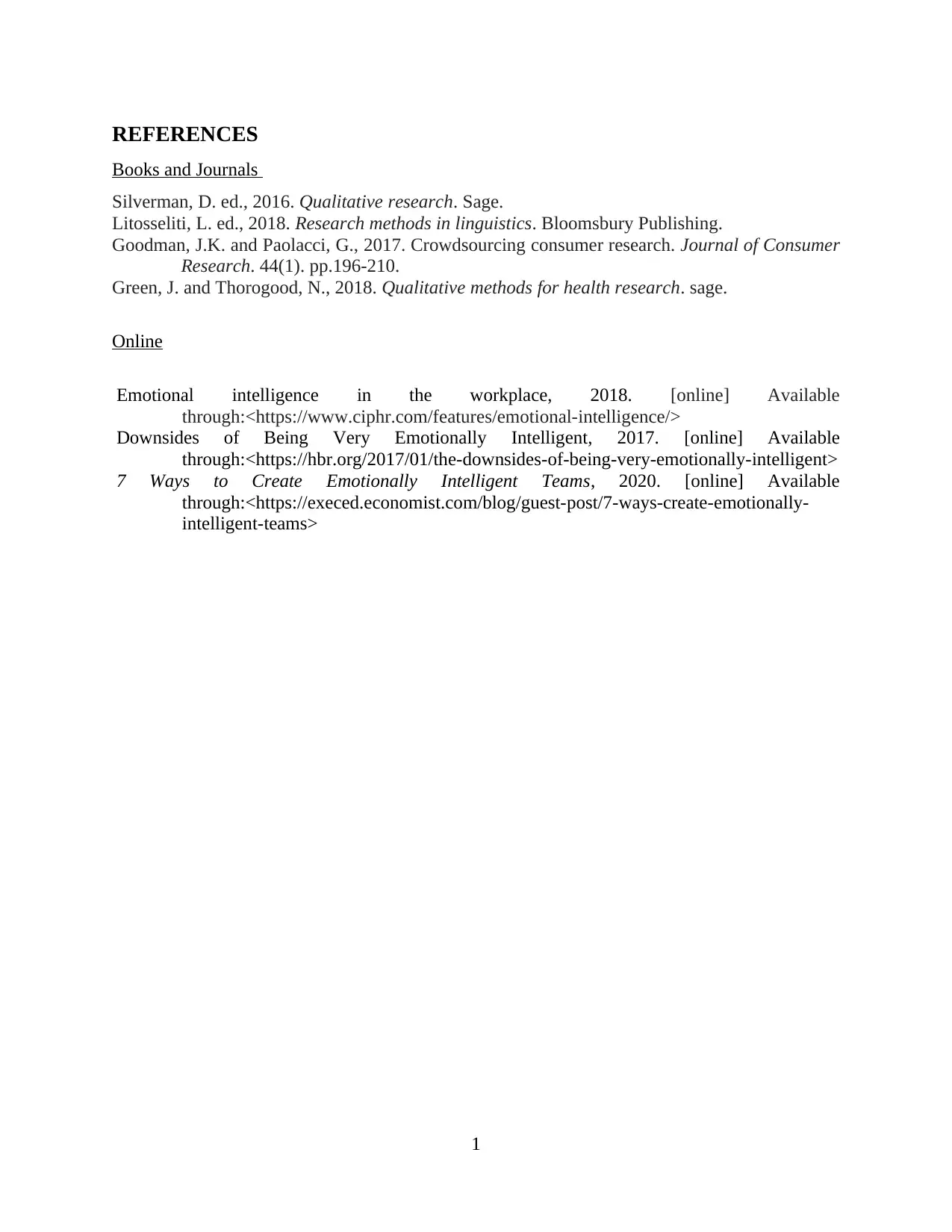
REFERENCES
Books and Journals
Silverman, D. ed., 2016. Qualitative research. Sage.
Litosseliti, L. ed., 2018. Research methods in linguistics. Bloomsbury Publishing.
Goodman, J.K. and Paolacci, G., 2017. Crowdsourcing consumer research. Journal of Consumer
Research. 44(1). pp.196-210.
Green, J. and Thorogood, N., 2018. Qualitative methods for health research. sage.
Online
Emotional intelligence in the workplace, 2018. [online] Available
through:<https://www.ciphr.com/features/emotional-intelligence/>
Downsides of Being Very Emotionally Intelligent, 2017. [online] Available
through:<https://hbr.org/2017/01/the-downsides-of-being-very-emotionally-intelligent>
7 Ways to Create Emotionally Intelligent Teams, 2020. [online] Available
through:<https://execed.economist.com/blog/guest-post/7-ways-create-emotionally-
intelligent-teams>
1
Books and Journals
Silverman, D. ed., 2016. Qualitative research. Sage.
Litosseliti, L. ed., 2018. Research methods in linguistics. Bloomsbury Publishing.
Goodman, J.K. and Paolacci, G., 2017. Crowdsourcing consumer research. Journal of Consumer
Research. 44(1). pp.196-210.
Green, J. and Thorogood, N., 2018. Qualitative methods for health research. sage.
Online
Emotional intelligence in the workplace, 2018. [online] Available
through:<https://www.ciphr.com/features/emotional-intelligence/>
Downsides of Being Very Emotionally Intelligent, 2017. [online] Available
through:<https://hbr.org/2017/01/the-downsides-of-being-very-emotionally-intelligent>
7 Ways to Create Emotionally Intelligent Teams, 2020. [online] Available
through:<https://execed.economist.com/blog/guest-post/7-ways-create-emotionally-
intelligent-teams>
1
1 out of 7
Related Documents
Your All-in-One AI-Powered Toolkit for Academic Success.
+13062052269
info@desklib.com
Available 24*7 on WhatsApp / Email
![[object Object]](/_next/static/media/star-bottom.7253800d.svg)
Unlock your academic potential
Copyright © 2020–2025 A2Z Services. All Rights Reserved. Developed and managed by ZUCOL.




